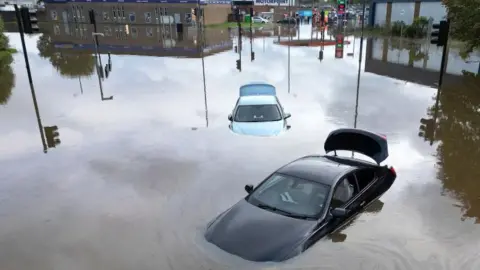In recent years, the impact of climate change has led to increased occurrences of natural disasters, notably floods and wildfires. These events have prompted a surge of innovation in the technology sector aimed at managing and mitigating the risks associated with such catastrophes. Following devastating incidents such as Storm Babet, which caused severe flooding across the UK in October 2023, there’s been a growing need for effective risk assessment tools for both individuals and corporations alike.
Consider the experience of Claire Sneddon from Trowell, Nottingham. When she purchased her home in 2021, she was reassured by the estate agent that a previous flood incident was a rare occurrence and that measures to prevent flooding were underway. However, despite initial confidence, her home was inundated during Storm Babet, leading to extensive damage and costly repairs totaling around £45,000. Unlike many others, she secured affordable insurance through a government scheme, but the stress of living under the constant threat of flooding remains a burden.
The environmental landscape is rapidly changing. According to the UK Environment Agency’s updated National Flood Risk Assessment in December, an alarming 6.3 million properties in England are currently at risk of flooding, with projections suggesting that number could rise to 8 million by 2050. This stark data highlights the urgent need for advanced monitoring and predictive tools designed to anticipate flooding and other climate-related threats.
To address these growing concerns, innovative companies have been developing cutting-edge technologies to assess climate risks more accurately than ever before. For instance, Climate X, a London-based firm, offers a unique digital platform that utilizes artificial intelligence alongside climate models to simulate extreme weather scenarios. Its technology allows for predictive modeling that integrates how rainfall interacts with various landscapes, ultimately giving banks and property ventures the data needed to evaluate climate risk more effectively.
As the market for disaster readiness technology expands, various players are entering the field. Companies like Faura in New York analyze the resilience of buildings to extreme weather, utilizing satellite imagery and disaster reports to produce assessments that indicate whether properties will withstand catastrophic events. These tools go beyond mere predictions of disaster occurrences to forecast the potential aftermath and damages—a significant enhancement, especially for insurers needing to manage their financial exposure to risks.
Over in the United States, similar services are increasingly crucial as areas face devastating wildfires and hurricanes. Notably, in early 2025, Los Angeles faced intense wildfire season, while Hurricane Milton prompted considerable damages in west Florida. In this context, technology firms are collaborating with insurance companies to provide detailed analytics on property resilience, an insight that is becoming indispensable in property evaluation and sales.
In fact, with platforms like Redfin emerging, homebuyers are now given critical information regarding their prospective properties’ exposure to natural disasters. As Daryl Fairweather, chief economist for Redfin, noted, climate risks significantly influence buying decisions. A homeowner’s decision may hinge on the risk of flooding or wildfire—but access to this data can significantly alter their choices.
In the wake of her unfortunate experience, Claire Sneddon now advocates for better awareness about flood risks in her community. Having transitioned to work with the FPS Group, she emphasizes the importance of understanding flood risk in the housing market. Sneddon underscores that flooding events do not just impact property but also significantly affect community mental health and wellbeing.
In conclusion, the intersection of technology and climate preparedness is becoming increasingly pertinent as we face an uncertain future punctuated by extreme weather events. As new tools are developed to predict and assess risks, they offer the hope of not only safeguarding property but also enhancing community resilience against environmental uncertainties. With flood and fire risk technology advancing, minimizing personal and financial losses in the face of climate change becomes ever more achievable.



